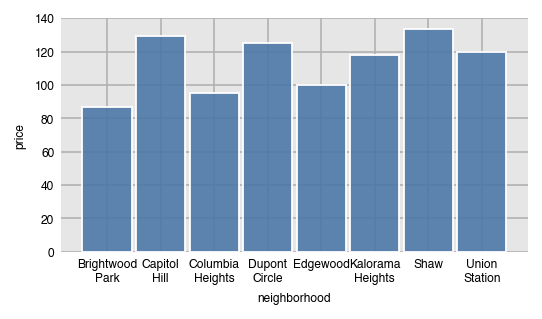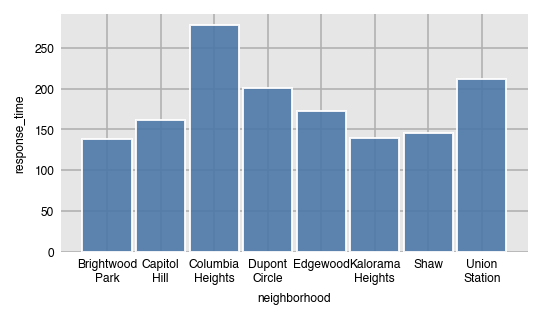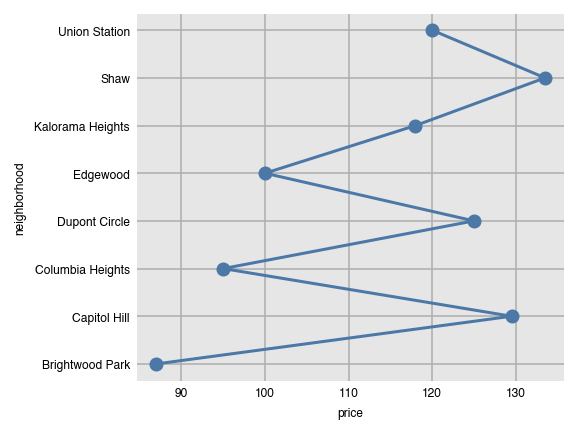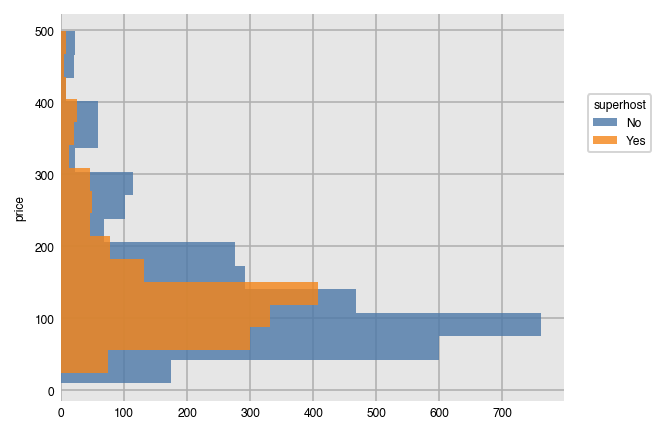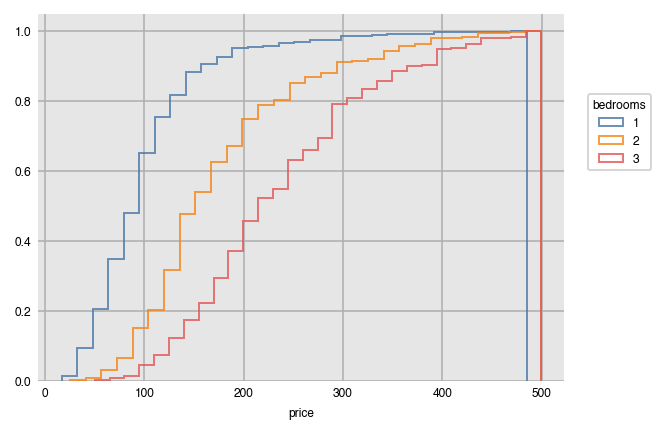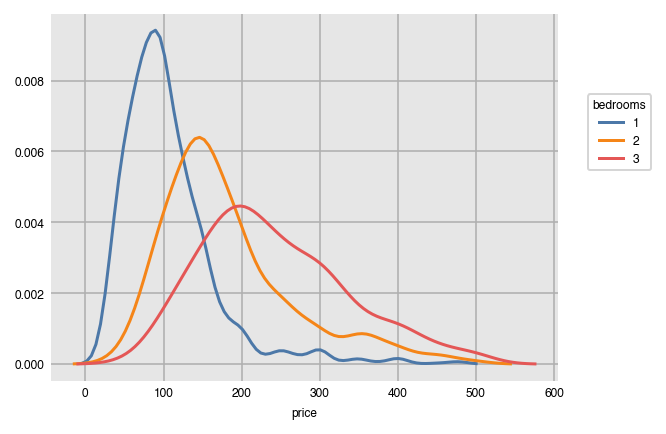Dexplot is a Python library for delivering beautiful data visualizations with a simple and intuitive user experience.
The primary goals for dexplot are:
- Maintain a very consistent API with as few functions as necessary to make the desired statistical plots
- Allow the user tremendous power without using matplotlib
pip install dexplot
Dexplot is primarily built for long data, which is a form of data where each row represents a single observation and each column represents a distinct quantity. It is often referred to as "tidy" data. Here, we have some long data.
Dexplot also has the ability to handle wide data, where multiple columns may contain values that represent the same kind of quantity. The same data above has been aggregated to show the mean for each combination of neighborhood and property type. It is now wide data as each column contains the same quantity (price).
Dexplot provides a small number of powerful functions that all work similarly. Most plotting functions have the following signature:
dxp.plotting_func(x, y, data, aggfunc, split, row, col, orientation, ...)x- Column name along the x-axisy- Column name the y-axisdata- Pandas DataFrameaggfunc- String of pandas aggregation function, 'min', 'max', 'mean', etc...split- Column name to split data into distinct groupsrow- Column name to split data into distinct subplots row-wisecol- Column name to split data into distinct subplots column-wiseorientation- Either vertical ('v') or horizontal ('h'). Default for most plots is vertical.
When aggfunc is provided, x will be the grouping variable and y will be aggregated when vertical and vice-versa when horizontal. The best way to learn how to use dexplot is with the examples below.
There are two primary families of plots, aggregation and distribution. Aggregation plots take a sequence of values and return a single value using the function provided to aggfunc to do so. Distribution plots take a sequence of values and depict the shape of the distribution in some manner.
- Aggregation
- bar
- line
- scatter
- count
- Distribution
- box
- violin
- hist
- kde
If you have used the seaborn library, then you should notice a lot of similarities. Much of dexplot was inspired by Seaborn. Below is a list of the extra features in dexplot not found in seaborn
- Ability to graph relative frequency and normalize over any number of variables
- No need for multiple functions to do the same thing (far fewer public functions)
- Ability to make grids with a single function instead of having to use a higher level function like
catplot - Pandas
groupbymethods available as strings - Ability to sort by values
- Ability to sort x/y labels lexicographically
- Ability to select most/least frequent groups
- x/y labels are wrapped so that they don't overlap
- Figure size (plus several other options) and available to change without using matplotlib
- A matplotlib figure object is returned
Most of the examples below use long data.
We'll begin by covering the plots that aggregate. An aggregation is defined as a function that summarizes a sequence of numbers with a single value. The examples come from the Airbnb dataset, which contains many property rental listings from the Washington D.C. area.
import dexplot as dxp
import pandas as pd
airbnb = dxp.load_dataset('airbnb')
airbnb.head()| neighborhood | property_type | accommodates | bathrooms | bedrooms | price | cleaning_fee | rating | superhost | response_time | latitude | longitude | |
|---|---|---|---|---|---|---|---|---|---|---|---|---|
| 0 | Shaw | Townhouse | 16 | 3.5 | 4 | 433 | 250 | 95.0 | No | within an hour | 38.90982 | -77.02016 |
| 1 | Brightwood Park | Townhouse | 4 | 3.5 | 4 | 154 | 50 | 97.0 | No | NaN | 38.95888 | -77.02554 |
| 2 | Capitol Hill | House | 2 | 1.5 | 1 | 83 | 35 | 97.0 | Yes | within an hour | 38.88791 | -76.99668 |
| 3 | Shaw | House | 2 | 2.5 | 1 | 475 | 0 | 98.0 | No | NaN | 38.91331 | -77.02436 |
| 4 | Kalorama Heights | Apartment | 3 | 1.0 | 1 | 118 | 15 | 91.0 | No | within an hour | 38.91933 | -77.04124 |
There are more than 4,000 listings in our dataset. We will use bar charts to aggregate the data.
airbnb.shape(4581, 12)
In order to performa an aggregation, you must supply a value for aggfunc. Here, we find the median price per neighborhood. Notice that the column names automatically wrap.
dxp.bar(x='neighborhood', y='price', data=airbnb, aggfunc='median')Line and scatter plots can be created with the same command, just substituting the name of the function. They both are not good choices for the visualization since the grouping variable (neighborhood) has no meaningful order.
dxp.line(x='neighborhood', y='price', data=airbnb, aggfunc='median')dxp.scatter(x='neighborhood', y='price', data=airbnb, aggfunc='median')Anytime the aggfunc parameter is set, you have performed a groupby aggregation, which always consists of three components:
- Grouping column - unique values of this column form independent groups (neighborhood)
- Aggregating column - the column that will get summarized with a single value (price)
- Aggregating function - a function that returns a single value (median)
The general format for doing this in pandas is:
df.groupby('grouping column').agg({'aggregating column': 'aggregating function'})Specifically, the following code is executed within dexplot.
airbnb.groupby('neighborhood').agg({'price': 'median'})| price | |
|---|---|
| neighborhood | |
| Brightwood Park | 87.0 |
| Capitol Hill | 129.5 |
| Columbia Heights | 95.0 |
| Dupont Circle | 125.0 |
| Edgewood | 100.0 |
| Kalorama Heights | 118.0 |
| Shaw | 133.5 |
| Union Station | 120.0 |
In addition to all the common aggregating functions, you can use the strings 'countna' and 'percna' to get the number and percentage of missing values per group.
dxp.bar(x='neighborhood', y='response_time', data=airbnb, aggfunc='countna')By default, the bars will be sorted by the grouping column (x-axis here) in alphabetical order. Use the sort_values parameter to sort the bars by value.
- None - sort x/y axis labels alphabetically (default)
asc- sort values from least to greatestdesc- sort values from greatest to least
dxp.bar(x='neighborhood', y='price', data=airbnb, aggfunc='median', sort_values='asc')Here, we sort the values from greatest to least.
dxp.bar(x='neighborhood', y='price', data=airbnb, aggfunc='median', sort_values='desc')Specify a specific order of the labels on the x-axis by passing a list of values to x_order. This can also act as a filter to limit the number of bars.
dxp.bar(x='neighborhood', y='price', data=airbnb, aggfunc='median',
x_order=['Dupont Circle', 'Edgewood', 'Union Station'])By default, x_order and all of the _order parameters are set to 'asc' by default, which will order them alphabetically. Use the string 'desc' to sort in the opposite direction.
dxp.bar(x='neighborhood', y='price', data=airbnb, aggfunc='median', x_order='desc')You can use x_order again to filter for the x-values that appear the most/least often by setting it to the string 'top n' or 'bottom n' where n is an integer. Here, we filter for the top 4 most frequently occurring neighborhoods. This option is useful when there are dozens of unique values in the grouping column.
dxp.bar(x='neighborhood', y='price', data=airbnb, aggfunc='median',
x_order='top 4')We can verify that the four neighborhoods are the most common.
airbnb['neighborhood'].value_counts()Columbia Heights 773
Union Station 713
Capitol Hill 654
Edgewood 610
Dupont Circle 549
Shaw 514
Brightwood Park 406
Kalorama Heights 362
Name: neighborhood, dtype: int64
Set orientation to 'h' for horizontal bars. When you do this, you'll need to switch x and y since the grouping column (neighborhood) will be along the y-axis and the aggregating column (price) will be along the x-axis.
dxp.bar(x='price', y='neighborhood', data=airbnb, aggfunc='median',
orientation='h', sort_values='desc')Switching orientation is possible for most other plots.
dxp.line(x='price', y='neighborhood', data=airbnb, aggfunc='median', orientation='h')You can split each bar into further groups by setting the split parameter to another column.
dxp.bar(x='neighborhood', y='price', data=airbnb, aggfunc='median', split='superhost')We can use the pivot_table method to verify the results in pandas.
airbnb.pivot_table(index='superhost', columns='neighborhood',
values='price', aggfunc='median')| neighborhood | Brightwood Park | Capitol Hill | Columbia Heights | Dupont Circle | Edgewood | Kalorama Heights | Shaw | Union Station |
|---|---|---|---|---|---|---|---|---|
| superhost | ||||||||
| No | 85.0 | 129.0 | 90.5 | 120.0 | 100.0 | 110.0 | 130.0 | 120.0 |
| Yes | 90.0 | 130.0 | 103.0 | 135.0 | 100.0 | 124.0 | 135.0 | 125.0 |
Set the order of the unique split values with split_order, which can also act as a filter.
dxp.bar(x='neighborhood', y='price', data=airbnb, aggfunc='median',
split='superhost', split_order=['Yes', 'No'])Like all the _order parameters, split_order defaults to 'asc' (alphabetical) order. Set it to 'desc' for the opposite.
dxp.bar(x='neighborhood', y='price', data=airbnb, aggfunc='median',
split='property_type', split_order='desc')Filtering for the most/least frequent split categories is possible.
dxp.bar(x='neighborhood', y='price', data=airbnb, aggfunc='median',
split='property_type', split_order='bottom 2')Verifying that the least frequent property types are Townhouse and Condominium.
airbnb['property_type'].value_counts()Apartment 2403
House 877
Townhouse 824
Condominium 477
Name: property_type, dtype: int64
Stack all the split groups one on top of the other by setting stacked to True.
dxp.bar(x='neighborhood', y='price', data=airbnb, aggfunc='median',
split='superhost', split_order=['Yes', 'No'], stacked=True)It's possible to split the data further into separate plots by the unique values in a different column with the row and col parameters. Here, each kind of property_type has its own plot.
dxp.bar(x='neighborhood', y='price', data=airbnb, aggfunc='median',
split='superhost', col='property_type')If there isn't room for all of the plots, set the wrap parameter to an integer to set the maximum number of plots per row/col. We also specify the col_order to be descending alphabetically.
dxp.bar(x='neighborhood', y='price', data=airbnb, aggfunc='median',
split='superhost', col='property_type', wrap=2, col_order='desc')Use col_order to both filter and set a specific order for the plots.
dxp.bar(x='neighborhood', y='price', data=airbnb, aggfunc='median',
split='superhost', col='property_type', col_order=['House', 'Condominium'])Splits can be made simultaneously along row and columns.
dxp.bar(x='neighborhood', y='price', data=airbnb, aggfunc='median', split='superhost',
col='property_type', col_order=['House', 'Condominium', 'Apartment'],
row='bedrooms', row_order=[1, 2, 3])By default, all axis limits are shared. Allow each plot to set its own limits by setting sharex and sharey to False.
dxp.bar(x='neighborhood', y='price', data=airbnb, aggfunc='median', split='superhost',
col='property_type', col_order=['House', 'Condominium', 'Apartment'],
row='bedrooms', row_order=[1, 2, 3], sharey=False)The width (height when horizontal) of the bars is set with the size parameter. By default, this value is .9. Think of this number as the relative width of all the bars for a particular x/y value, where 1 is the distance between each x/y value.
dxp.bar(x='neighborhood', y='price', data=airbnb,
aggfunc='median', split='property_type',
split_order=['Apartment', 'House'],
x_order=['Dupont Circle', 'Capitol Hill', 'Union Station'], size=.5)All the other aggregating plots work similarly.
dxp.line(x='neighborhood', y='price', data=airbnb,
aggfunc='median', split='property_type',
split_order=['Apartment', 'House'],
x_order=['Dupont Circle', 'Capitol Hill', 'Union Station'])Distribution plots work similarly, but do not have an aggfunc since they do not aggregate. They take their group of values and draw some kind of shape that gives information on how that variable is distributed.
Box plots have colored boxes with ends at the first and third quartiles and a line at the median. The whiskers are placed at 1.5 times the difference between the third and first quartiles (Interquartile range (IQR)). Fliers are the points outside this range and plotted individually. By default, both box and violin plots are plotted horizontally.
dxp.box(x='price', y='neighborhood', data=airbnb)Split the groups in the same manner as with the aggregation plots.
dxp.box(x='price', y='neighborhood', data=airbnb,
split='superhost', split_order=['Yes', 'No'])Order the appearance of the splits alphabetically (in descending order here).
dxp.box(x='price', y='neighborhood', data=airbnb,
split='property_type', split_order='desc')It's possible to filter the range of possible values by passing in a list of the minimum and maximum to x_order.
dxp.box(x='price', y='neighborhood', data=airbnb,
split='superhost', x_order=[50, 250])Change the x and y while setting orientation to make vertical bar plots.
dxp.box(x='neighborhood', y='price', data=airbnb, orientation='v',
split='property_type', split_order='top 2')Violin plots work identically to box plots, but show "violins", kernel density plots duplicated on both sides of a line.
dxp.violin(x='price', y='neighborhood', data=airbnb,
split='superhost', split_order=['Yes', 'No'])Splitting by rows and columns is possible as well with distribution plots.
dxp.box(x='price', y='neighborhood', data=airbnb,split='superhost',
col='property_type', col_order=['House', 'Condominium', 'Apartment'],
row='bedrooms', row_order=[1, 2])Histograms work in a slightly different manner. Instead of passing both x and y, you give it a single numeric column. A vertical histogram with 20 bins of the counts is created by default.
dxp.hist(val='price', data=airbnb)We can use split just like we did above and also create horizontal histograms.
dxp.hist(val='price', data=airbnb, orientation='h', split='superhost', bins=15)Here, we customize our histogram by plotting the cumulative density as opposed to the raw frequency count using the outline of the bars ('step').
dxp.hist(val='price', data=airbnb, split='bedrooms', split_order=[1, 2, 3],
bins=30, density=True, histtype='step', cumulative=True)Kernel density estimates provide an estimate for the probability distribution of a continuous variable. Here, we examine how price is distributed by bedroom.
dxp.kde(x='price', data=airbnb, split='bedrooms', split_order=[1, 2, 3])Graph the cumulative distribution instead on multiple plots.
dxp.kde(x='price', data=airbnb, split='bedrooms',
split_order=[1, 2, 3], cumulative=True, col='property_type', wrap=2)Provide two numeric columns to x and y to get a two dimensional KDE.
dxp.kde(x='price', y='cleaning_fee', data=airbnb)Create a grid of two-dimensional KDE's.
dxp.kde(x='price', y='cleaning_fee', data=airbnb, row='neighborhood', wrap=3)The count function graphs the frequency of unique values as bars. By default, it plots the values in descending order.
dxp.count(val='neighborhood', data=airbnb)In pandas, this is a straightforward call to the value_counts method.
airbnb['neighborhood'].value_counts()Columbia Heights 773
Union Station 713
Capitol Hill 654
Edgewood 610
Dupont Circle 549
Shaw 514
Brightwood Park 406
Kalorama Heights 362
Name: neighborhood, dtype: int64
Instead of the raw counts, get the relative frequency by setting normalize to True.
dxp.count(val='neighborhood', data=airbnb, normalize=True)Here, we split by property type.
dxp.count(val='neighborhood', data=airbnb, split='property_type')In pandas, this is done with the crosstab function.
pd.crosstab(index=airbnb['property_type'], columns=airbnb['neighborhood'])| neighborhood | Brightwood Park | Capitol Hill | Columbia Heights | Dupont Circle | Edgewood | Kalorama Heights | Shaw | Union Station |
|---|---|---|---|---|---|---|---|---|
| property_type | ||||||||
| Apartment | 167 | 299 | 374 | 397 | 244 | 284 | 315 | 323 |
| Condominium | 35 | 70 | 97 | 62 | 65 | 42 | 52 | 54 |
| House | 131 | 137 | 157 | 47 | 146 | 23 | 61 | 175 |
| Townhouse | 73 | 148 | 145 | 43 | 155 | 13 | 86 | 161 |
Horizontal stacked count plots.
dxp.count(val='neighborhood', data=airbnb, split='property_type',
orientation='h', stacked=True, col='superhost')Setting normalize to True, returns the relative frequency with respect to all of the data. You can normalize over any of the variables provided.
dxp.count(val='neighborhood', data=airbnb, split='property_type', normalize='neighborhood',
title='Relative Frequency by Neighborhood')Normalize over several variables at once with a list.
dxp.count(val='neighborhood', data=airbnb, split='superhost',
row='property_type', col='bedrooms', col_order=[1, 2],
normalize=['neighborhood', 'property_type', 'bedrooms'], stacked=True)Dexplot can also plot wide data, or data where no aggregation happens. Here is a scatter plot of the location of each listing.
dxp.scatter(x='longitude', y='latitude', data=airbnb,
split='neighborhood', col='bedrooms', col_order=[2, 3])If you've already aggregated your data, you can plot it directly without specifying x or y.
df = airbnb.pivot_table(index='neighborhood', columns='property_type',
values='price', aggfunc='mean')
df| property_type | Apartment | Condominium | House | Townhouse |
|---|---|---|---|---|
| neighborhood | ||||
| Brightwood Park | 96.119760 | 105.000000 | 121.671756 | 133.479452 |
| Capitol Hill | 141.210702 | 104.200000 | 170.153285 | 184.459459 |
| Columbia Heights | 114.676471 | 126.773196 | 135.292994 | 124.358621 |
| Dupont Circle | 146.858942 | 130.709677 | 179.574468 | 139.348837 |
| Edgewood | 108.508197 | 112.846154 | 156.335616 | 147.503226 |
| Kalorama Heights | 122.542254 | 155.928571 | 92.695652 | 158.230769 |
| Shaw | 153.888889 | 158.500000 | 202.114754 | 173.279070 |
| Union Station | 128.458204 | 133.833333 | 162.748571 | 162.167702 |
dxp.bar(data=df, orientation='h')stocks = pd.read_csv('../data/stocks10.csv', parse_dates=['date'], index_col='date')
stocks.head()| MSFT | AAPL | SLB | AMZN | TSLA | XOM | WMT | T | FB | V | |
|---|---|---|---|---|---|---|---|---|---|---|
| date | ||||||||||
| 1999-10-25 | 29.84 | 2.32 | 17.02 | 82.75 | NaN | 21.45 | 38.99 | 16.78 | NaN | NaN |
| 1999-10-26 | 29.82 | 2.34 | 16.65 | 81.25 | NaN | 20.89 | 37.11 | 17.28 | NaN | NaN |
| 1999-10-27 | 29.33 | 2.38 | 16.52 | 75.94 | NaN | 20.80 | 36.94 | 18.27 | NaN | NaN |
| 1999-10-28 | 29.01 | 2.43 | 16.59 | 71.00 | NaN | 21.19 | 38.85 | 19.79 | NaN | NaN |
| 1999-10-29 | 29.88 | 2.50 | 17.21 | 70.62 | NaN | 21.47 | 39.25 | 20.00 | NaN | NaN |
dxp.line(data=stocks.head(500))



